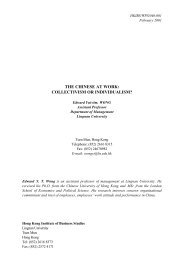West Rail vs. Bus - Lingnan University Library
West Rail vs. Bus - Lingnan University Library
West Rail vs. Bus - Lingnan University Library
Create successful ePaper yourself
Turn your PDF publications into a flip-book with our unique Google optimized e-Paper software.
pass. But it should be noted that price is not the only factor that attracts passengers.<br />
Other factors like the level of service also affect passenger amount. Passengers may<br />
not accept bad service even if the fare is low.<br />
Time cost is similar to value of time. It is the cost that people are willing to<br />
pay for a certain amount of time saved. In the example of work trip, the time cost is<br />
larger for a passenger who earns $1,000 per hour than someone who only earns $100<br />
an hour. The passengers who earn more will pay a larger amount for a stable service<br />
because they may lose more money when they are late.<br />
People are willing to pay an extra cost to avoid congestion and danger. For<br />
example, railway has better control of time of arrival than bus. Also, its accident rate<br />
is much lower than the vehicles. People who want to have a safe and stable service<br />
tend to pay a higher fare for the railway service rather than the road transport.<br />
Trip Purpose<br />
As mentioned above, there are mainly eight types of trip purposes. Each<br />
purpose can affect the choice of transportation mode. Recreation and school trips are<br />
normally short rips. Passengers of short trips are often reluctant to interchange to<br />
other routes or transport modes many times. Passengers for long distance trips are<br />
more willing to accept interchange to other routes or transport modes more than once<br />
to save time.<br />
24









